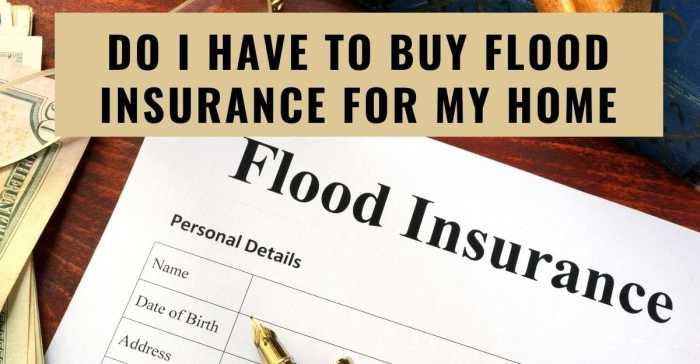
Flash flood coverage in home insurance is a crucial component for homeowners, especially in areas susceptible to severe weather events. Flash floods can occur with little warning, leaving devastating financial impacts on those unprepared. Understanding how flash flood coverage works and its significance in protecting your property is vital for every homeowner.
This coverage is not just an add-on; it offers essential protection against one of nature’s most unpredictable threats. With climate change influencing weather patterns, the need for adequate flood protection is more pressing than ever.
Importance of Flash Flood Coverage in Home Insurance

Including flash flood coverage in home insurance policies is essential for homeowners, especially in areas prone to heavy rainfall and flooding. Flash floods can occur suddenly and with great intensity, often leaving little time for preparation. This type of coverage protects homeowners from the devastating financial consequences associated with flood damage, which standard policies typically do not cover.The potential financial impact of flash floods on homeowners is significant, with damage costs running into thousands of dollars.
According to the National Flood Insurance Program (NFIP), flooding is the most common and widespread natural disaster in the United States, and it can happen anywhere, not just in high-risk areas. For instance, a flash flood can result in damages to the foundation, electrical systems, and personal belongings within the home, leading to substantial repair and replacement costs. Homeowners without adequate coverage may find themselves facing financial hardship, as they may have to bear the entire cost of repairs out-of-pocket.
Differences Between Standard Home Insurance and Policies with Flood Coverage
Understanding the differences between standard home insurance and policies that include flood coverage is crucial for homeowners seeking comprehensive protection. Standard home insurance generally covers various risks, such as fire, theft, and some types of water damage, but it typically excludes flood-related incidents. This exclusion can leave homeowners vulnerable when flash floods strike.To clarify this important distinction, here are some key differences:
- Coverage Scope: Standard home insurance policies usually cover structural damage from most perils, but flood damage is specifically excluded. In contrast, flood insurance provides coverage for damages caused by rising water, which can occur suddenly during heavy rain or from broken levees.
- Policy Requirements: Many lenders require homeowners in designated flood zones to obtain separate flood insurance. However, even homeowners outside these zones can benefit from flood insurance, as weather patterns can be unpredictable.
- Claims Process: Flood insurance claims are handled differently than standard home insurance claims. The National Flood Insurance Program (NFIP) offers standardized policies, which can streamline the claims process but also comes with specific limits and conditions.
- Financial Protection Limits: The maximum coverage available under NFIP policies is $250,000 for the structure and $100,000 for personal belongings. Homeowners may need to consider additional private flood insurance options for higher coverage limits.
“Floods are not just a coastal issue; they can affect homes anywhere, making flash flood coverage a critical component of any comprehensive home insurance policy.”
Factors Influencing Flash Flood Risk and Insurance Rates
Flash floods can strike suddenly, often leaving homeowners vulnerable and unprepared. Understanding the various factors that influence flash flood risk can help individuals make informed decisions about their home insurance. This segment explores the geographical areas at the highest risk, the impact of climate change, and the role of government regulations in shaping insurance premiums.
Geographical Areas at Risk for Flash Floods
Certain regions are more prone to flash floods due to their topography, climate, and proximity to bodies of water. Areas with steep terrain, such as mountains and hills, can experience rapid runoff during heavy rains, leading to flash floods. Urban environments, where impervious surfaces increase water runoff, are also at heightened risk. The following regions are particularly vulnerable:
- Coastal Areas: Regions near oceans or large lakes face risks from storm surges and heavy rainfall.
- River Basins: Areas near rivers can flood, especially during periods of intense rainfall or rapid snowmelt.
- Mountainous Regions: Steep slopes can lead to flash floods from sudden downpours, creating dangerous conditions.
- Urban Centers: Cities with poor drainage systems are more likely to experience flooding during heavy storms.
As a result, homeowners in these areas often face higher insurance premiums. Insurers evaluate the flood risk based on geographical location, which plays a significant role in determining rates.
Impact of Climate Change on Flash Flood Occurrences
The relationship between climate change and flash flood occurrences is increasingly apparent. Rising global temperatures contribute to more intense and frequent rainfall events, which can overwhelm drainage systems and lead to sudden flooding. Studies indicate that areas experiencing more extreme weather patterns are likely to see an uptick in flash floods.For example, regions that have historically experienced mild weather are now witnessing extreme storms and flash flooding, including areas in the Midwest and Southern United States.
This shift raises concerns among insurers, prompting them to adjust premiums to reflect heightened risks.
“Climate change is altering rainfall patterns, making flash floods more common in many regions.”
Government Regulations and Flood Zone Designations
Government regulations and flood zone designations significantly influence insurance costs. The Federal Emergency Management Agency (FEMA) designates flood zones based on risk assessments, impacting how insurers determine premiums. Homeowners located in high-risk flood zones may be required to carry flood insurance, which can substantially increase overall insurance costs.The following factors illustrate how government regulations dictate insurance rates:
- Flood Zone Classification: Properties in designated high-risk zones typically incur higher premiums than those in low-risk areas.
- Building Codes: Compliance with stricter building codes in flood-prone areas can help mitigate insurance costs over time.
- Funding for Flood Control Projects: Government investments in flood defenses can lower risk assessments, potentially reducing insurance rates for homeowners.
- Disaster Declarations: Areas declared disaster zones may see temporary adjustments in insurance rates following catastrophic events.
In summary, understanding these factors can empower homeowners to navigate their insurance options more effectively. By staying informed about the geographical, environmental, and regulatory landscape, homeowners can better protect their properties and finances against the risks associated with flash floods.
Comparison with Other Types of Insurance

When it comes to insurance, different types cater to unique risks and needs. Flash flood insurance is specifically designed to protect homeowners from the financial impacts of flooding, a peril that can cause significant damage. In comparison, other types of insurance, such as dental and disability insurance, address different aspects of life. Understanding these differences is crucial for homeowners and individuals seeking comprehensive protection.
Comparison of Flood Insurance and Dental Insurance
Flood insurance and dental insurance have distinct purposes and risk assessments. Flood insurance is designed to cover losses from water damage due to heavy rainfall or flooding, with premiums based on geographic risk factors and historical flood data. On the other hand, dental insurance typically involves a flat monthly premium and covers routine dental care, such as check-ups and cleanings, with limited coverage for major procedures.The risk assessment for flood insurance is heavily influenced by location and the likelihood of flooding, while dental insurance’s risk assessment focuses on an individual’s dental health history and preventative care needs.
This difference highlights the nature of risks associated with each type of insurance: flood insurance safeguards against natural disasters, while dental insurance is more about personal health management.
Significance of Disability Insurance in Relation to Natural Disasters
Disability insurance provides income protection for individuals who are unable to work due to illness or injury. In the context of natural disasters, including flash floods, this type of insurance becomes vital. If a homeowner is affected by a flood, they may face physical injuries or psychological impacts that prevent them from returning to work. Disability insurance can bridge the financial gap during recovery, ensuring that families can maintain their living standards despite the challenges posed by the disaster.
The significance of this coverage amplifies when considering the unexpected nature of natural disasters, emphasizing the need for comprehensive risk management.
Comparison Table of Flash Flood Insurance and Health Insurance
The differences between flash flood insurance and health insurance can be summarized in the following table, focusing on coverage limitations and benefits:
| Aspect | Flash Flood Insurance | Health Insurance |
|---|---|---|
| Purpose | Covers property damage caused by flooding | Covers medical expenses and health-related costs |
| Coverage Limitations | Typically limited to flood-related damages; does not cover other water damage | May have limits on specific treatments and procedures; annual out-of-pocket maximums |
| Benefits | Financial protection against significant property loss | Access to medical care, preventative services, and treatment for illnesses/injuries |
| Risk Assessment | Based on geographic flood risk and historical data | Based on health history, demographics, and lifestyle factors |
“Understanding the nuances of different insurance types is essential for effective risk management and financial planning.”
Closure
In conclusion, ensuring you have flash flood coverage in your home insurance policy could be the difference between recovering from a disaster or facing severe financial strain. As the frequency of flash floods increases, staying informed and prepared is key to safeguarding your home and peace of mind.
FAQ
What is flash flood coverage?
Flash flood coverage protects homeowners from financial losses due to sudden and intense flooding events.
Is flash flood coverage included in standard home insurance?
No, flash flood coverage is typically not included in standard home insurance and must be purchased separately.
How do I know if I’m in a flood zone?
You can check flood zone maps provided by FEMA or your local government to determine your risk level.
What factors affect flash flood insurance premiums?
Geographical location, property elevation, and proximity to water bodies significantly impact insurance premiums.
Can I purchase flash flood insurance at any time?
Generally, yes, but there may be a waiting period before the coverage takes effect, especially after a flood warning.





